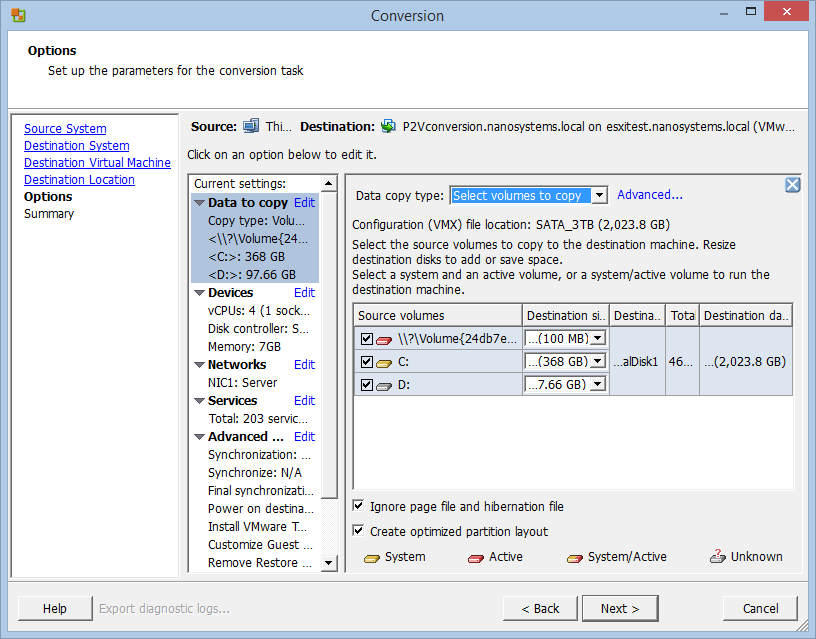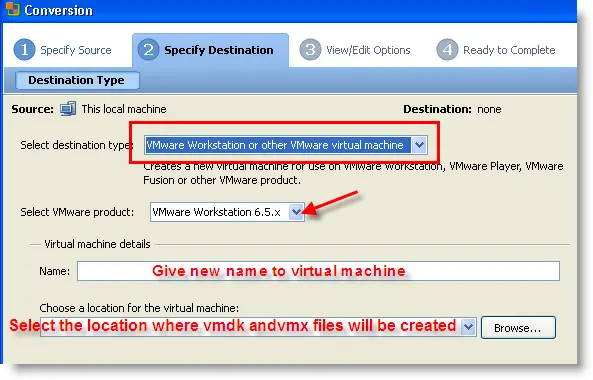Update 2
In early 2016, VMware began including the embedded HTML5 host client for managing ESXi in version 6.0 U2 from your web browser. Meant to connect to and manage single ESXi clients, it’s a great solution for users getting started with a dedicated Mac (like a quad-core mini or a Mac Pro) running VMware at MacStadium.
Update
The venerable William Lam of virtuallyGhetto noticed we were missing ESXi Embedded Host Client. He wrote a great article on this tool explaining its use that's worth checking out. We're ready to add any other suggestions that our readers may have.
Here’s the Situation
You can convert powered on physical machines, VMware virtual machines, and Hyper-V Server virtual machines into VMware standalone virtual machines or virtual machines that vCenter Server manages. The approach you take for creating the conversion job is determined by the type of source and the type of destination that you select. Vmware vcenter converter standalone client synchronize not working Cannot access (MAC) Host shared file system from within VMware vCenter Converter Standalone Client when desiring to create a VMware image (Windows 7 running in Parallels VM on a MAC) for the Powered-On machine option. This is the VMware Organizational Unique Identifier (OUI). How does 4th octet of VM MAC address are calculated? Let’s begin the Calculation. 4th Octet of MAC = (128+ vCenter Instance ID) Convert it to Hexadecimal. To get the vCenter Server Instance ID - Login to vSphere Client -Administration - vCenter Server Settings - Runtime Settings. VCenter Converter supports many source physical machines, including Windows and Linux desktop and server editions. It also supports conversion of third-party virtual machines like Hyper-V and KVM. VMware vCenter Converter. Accomplish your virtualization goals using VMware Accelerators to rapidly migrate existing physical environments, or 3rd party system images to VMware virtual machines.
You’ve just had a Mac mini setup with ESXi to move all of your software onto one machine. VMware ESXi is a great option to get the most out of a single server at MacStadium as it’s the only enterprise option available for virtualizing OS X, Windows, and Linux on one machine.
Vmware Vcenter Converter For Mac Windows 10
You’re probably using MacStadium because you personally use a Mac (let’s call it a MacBook Pro) for day-to-day work and recognize the potential of a hosted Mac. Rather than continue paying more for shared hosting at another provider (without OS X of course) you’d like one place to manage all of your servers.
The next step is obviously connecting to and managing your VMware single-server ESXi environment. This is where the VMware vSphere software suite comes into play. But wait, you've only got the MacBook Pro! Unfortunately for developers working on Apple hardware locally, there is no native VMware vSphere client available for OS X. Don’t give up, though; there are alternatives.
Will There Ever be a Desktop App for OS X?
There was a glimmer of hope for Mac users in a preview of VMware vSphere 6.0. A thick (desktop) client was included that could be installed locally by Windows and Mac users (and presumably Linux in the future). Unfortunately, it disappeared in the next release candidate and has not been seen again.
Can I Use vSphere Web Client?
In older versions of VMware vSphere, a Windows desktop was the primary means of accessing vSphere environments. Now though, more and more users are taking advantage of the vSphere web client to access vSphere.
The catch with vSphere Web Client is that it’s only accessible if you have vCenter. On a single-server solution running ESXi, that means $99/month. Don’t give up hope just yet.
What About VMware Fusion?
If you’re a recent convert to virtualization and tested the waters in VMware Fusion Pro on your local Mac machine, you’re in luck. VMware Fusion Pro for Mac includes the only truly native client for accessing your remote vSphere environment from OS X. If you’re not already using Fusion Pro is it worth it to purchase a license? At $200, it might be a hard sell for managing your single ESXi host.
Can I Use Windows on my Mac?
If you’ve got Boot Camp on your Mac, you could save all of your work to a remote or shared partition, log out, reboot into Windows, open up your shared partition or remote folder, open the vSphere client, and finally connect to vSphere and manage your virtual machines. That’s a lot of steps but it is a viable solution. You could also run a Windows VM in VMware Fusion or Workstation Player.
Is There Command Line Access?

Yes, you can partially manage your ESXi server using SSH. You’ll have to have access to a vSphere client temporarily to enable SSH access in ESXi. vCLI, the VMware vSphere Command-Line Interface, is also an alternative for management from a Linux or Windows system.
Does MacStadium Offer any Alternatives?
For single-server ESXi installations, we can make sure your server is always available whenever you need access from one of the above options. If you are in a testing phase and plan to move to a multi-host ESXi cluster, there is great news. We offer vCenter to all private cloud environments. A team of users on Mac’s can all manage vSphere using the included vSphere Web Client.
Don’t hesitate to reach us over live chat or by opening a support ticket if you have questions or need help with your Mac servers running ESXi.
References
VMware vCenter Converter is a free tool that’s been around for a while. If you’ve been working with VMware products in the past, there’s a good chance you’ve already used it and possibly ran into issues with migration. Once in a while though, I run into people who ask me for my pro-tips and ask for a run through of the tool. I wanted to put together some tips in this post, and show the tool to you in a quick video.
1. Make sure you use the latest version
VMware occasionally updates this tool, and having the newest version will get you the latest features. In the past, if I had any migration issues, it was easily resolved with a simple update.
2. Disable any Antivirus
I have had issues with Antivirus scans causing issues with migrations. Disable them if you can.
Vmware Vcenter Converter For Mac Download
3. If possible use it locally and not remotely
You get two options, a local migration where you install VMware Converter on the machine you want to migrate and remotely, where you run it from your own machine and point it to the remote machine. If a remote conversion fails, try a local migration.
4. If allowed, disable SSL to speed up the transfers
This will dramatically speed up your migrations as the data being moved won’t be encrypted. If your company policies allow it, you’ll save a significant amount of time by turning off SSL.
5. Know the local Administrator password, or cache your AD credentials
Vmware Vcenter Converter Standalone Configure Machine
This tip also works hand-in-hand with #6. You want to cache your Active Directory credentials because when you migrate, the new machine will have new NICs, therefore you won’t be able to get online to login to the domain. Having the local Administrator account handy will help.
Vmware Vcenter Converter For Mac Download
6. Note your existing IPs. You will get new NICs after the move
At the destination machine, you will have altogether different NICs, you will want to re-IP the machine after the move. I generally recommend doing an “ipconfig /all > c:IPs.txt” before you kick off the migration. Bonus points if you log in with AD credentials and cache to do this process as well.

If you need to change your IP, here’s how to do it: How to Change the IP Configuration of vCenter Server Appliance
7. Remove any vendor specific software
Just do your due diligence and clean up the image. There’s no need for any vendor related “junk” on the image anymore. Remove it!
8. Use the vmxnet3 adapter after the move
The vmxnet3 adapter performs far better than the E1000 adapter, so use those when migrating. It will save you headaches later.
9. Disable any services that can cause major disk activity
If you don’t disable services that cause disk activity, there is a possibility that the migration won’t ever complete, or it will take an exceptionally long time. I try to disable any services I can. If it means I have to do it off hours, I’ll do it then.
10. Shrink disk sizes and rightsize during the move
Part of the migration process should be rightsizing the machine. Most of the physical servers around are too big. There is a reason we’re moving them to VMs. Shrink the memory, disk and CPU footprint anytime you can.
Wrap Up
vCenter Converter is a great tool. If you follow the tips above, you should have many successful migrations. I’d say minimizing I/O during the migration is the biggest beneficial thing you can do if for some reason a migration fails. Good luck!
Are you a vSphere Superhero? Find out: Top 10 Critical Skills Every vSphere System Administrator Should Know
Download Altaro VM Backup
Vcenter Converter Download
Start your free 30-day trial of Altaro VM Backup today and see why it's trusted by 40 000+ organizations worldwide. Get started now and run your first backup in under 15 mins!